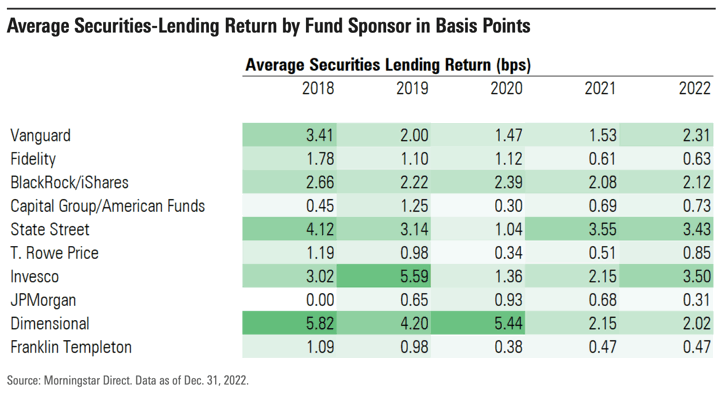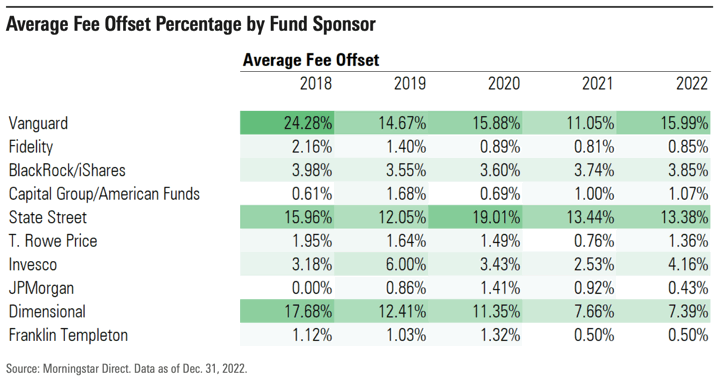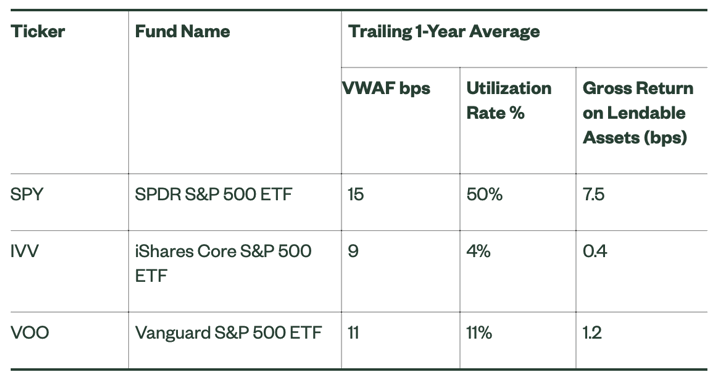 Morningstar has an educational article called Understanding Securities Lending in ETFs (also see the full whitepaper) that provided a lot of real-world numbers in an often overlooked area that actually affects the majority of ETF and mutual fund investors. ETFs hold a basket of stocks, and securities lending is the practice where the fund sponsor lends out some of those stocks for a fee. Borrowers may include hedge funds participating in a short or arbitrage play, or broker/dealers that need some shares to cover their own settlement needs.
Morningstar has an educational article called Understanding Securities Lending in ETFs (also see the full whitepaper) that provided a lot of real-world numbers in an often overlooked area that actually affects the majority of ETF and mutual fund investors. ETFs hold a basket of stocks, and securities lending is the practice where the fund sponsor lends out some of those stocks for a fee. Borrowers may include hedge funds participating in a short or arbitrage play, or broker/dealers that need some shares to cover their own settlement needs.
If you own a Vanguard/Fidelity/Blackrock Target Retirement Fund or Total Stock Market ETF, you are benefiting from securities lending and earning a slightly higher return over time (while taking on a tiny bit of extra risk). Every major ETF and mutual fund provider, including Vanguard, Fidelity, Blackrock/iShares, State Street (SPDRs), American Funds, and T. Rowe Price participates in this practice.
Securities lending historically adds an average of around 0.005% to 0.03% of extra annual return. This means that for every $10,000 invested, you might earn an extra $0.50 to $3 a year. Here’s a Morningstar chart of the average securities lending return by sponsor. 1 basis point = 0.01%. It’s hard to tell if any differences are due to some level of operational skill, or that their holdings are simply more attractive to borrowers (more smaller stocks, more crypto stocks or whatever has higher short interest).

Due to the low expense ratios in many index funds, securities lending can significantly offset expense ratios. Securities lending interest usually goes toward quietly increasing the fund’s performance a little bit, as opposed to directly reducing the management expense ratio. Here’s a table of how much of each fund sponsor’s expense ratios are offset by securities lending income overall. Not surprisingly, the fund sponsors with mostly low-cost ETFs have the highest offset percentages.

Are some index ETFs already effectively free? The WSJ says index funds are almost free after State Street’s SPDR Portfolio S&P 500 ETF (SPLG) recently lowered its expense ratio to 0.02%, but given this information, it’s quite conceivable that the real “net” expense is already very close to zero, if not at zero.
These are all pretty small numbers for most individual investors. However, given the tiny expense ratio differences between index ETFs and the huge amount of assets held by them, the importance of every single basis point of additional performance is magnified. I’m glad to see that Vanguard remains competitive in this area, but also not overly aggressive.
Side note: Can individual investors earn even more extra income lending out the ETFs themselves? There is also the possibility of owning an ETF and lending out those entire ETF shares for interest. State Street runs the popular S&P 500 ETF SPY and in the article Unlocking the Securities Lending Potential of SPY makes the case that even though its ETF has a higher expense ratio that say Vanguard’s S&P 500 ETF VOO, the fact that SPY is the most popular ETF used for shorting the S&P 500 means that you might possibly net 8-9 basis points in this manner. The article appears to be targeted to institutional clients, so I’m not sure if any retail customers are getting anywhere near this amount of securities lending income. For my own portfolio as a whole, instead of even a single basis point, I am currently earning less than 0.04 basis points at Fidelity.

Even in the ideal case, retail customers only get about half of the gross income that the broker earns (a 50/50 split), and so given that VOO is still beating SPY in terms of straight-up 5-year past performance by 6 basis points or so every year, even if you allow the theoretical lending edge of 0.06% (with half or 3 basis points going to the investors), that still leaves VOO ahead of SPY. But as a practical matter, has anyone out there actually earned any income lending out their index ETFs? I haven’t; I’d imagine the supply would greatly outpace the demand.
 The Best Credit Card Bonus Offers – 2025
The Best Credit Card Bonus Offers – 2025 Big List of Free Stocks from Brokerage Apps
Big List of Free Stocks from Brokerage Apps Best Interest Rates on Cash - 2025
Best Interest Rates on Cash - 2025 Free Credit Scores x 3 + Free Credit Monitoring
Free Credit Scores x 3 + Free Credit Monitoring Best No Fee 0% APR Balance Transfer Offers
Best No Fee 0% APR Balance Transfer Offers Little-Known Cellular Data Plans That Can Save Big Money
Little-Known Cellular Data Plans That Can Save Big Money How To Haggle Your Cable or Direct TV Bill
How To Haggle Your Cable or Direct TV Bill Big List of Free Consumer Data Reports (Credit, Rent, Work)
Big List of Free Consumer Data Reports (Credit, Rent, Work)
At first, there was no activity. But last month, I received $33 from ITB (ISHARES TR US HOME CONS ETF) in my Roth IRA. Another $7 of it was in my traditional IRA from IWO and EMXC.
Interesting, thanks for sharing.